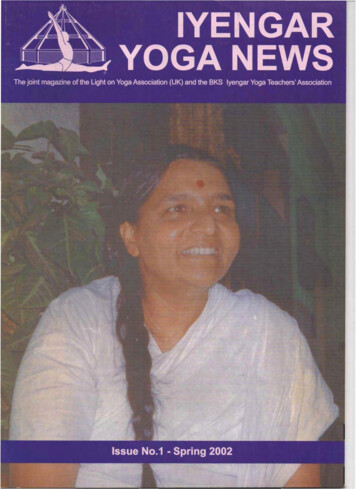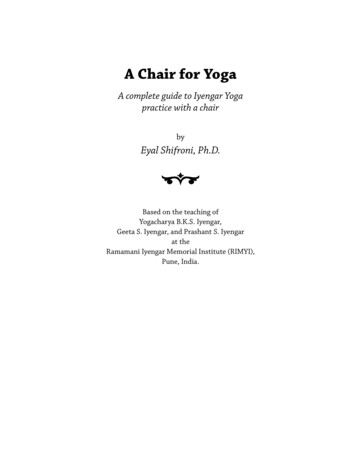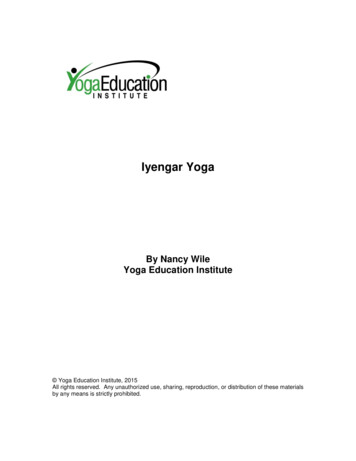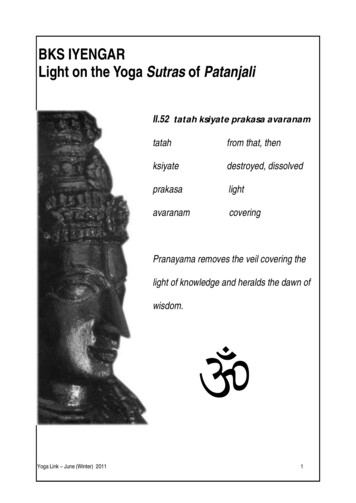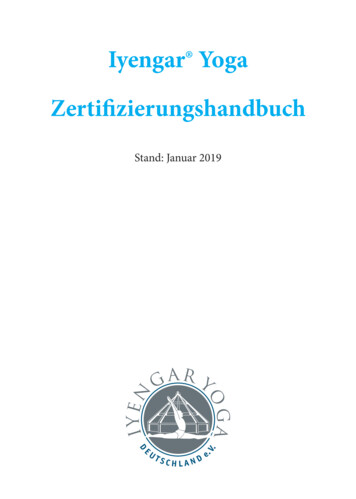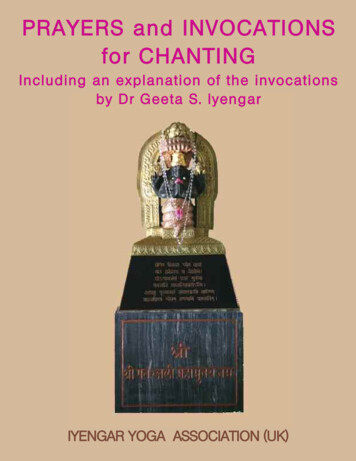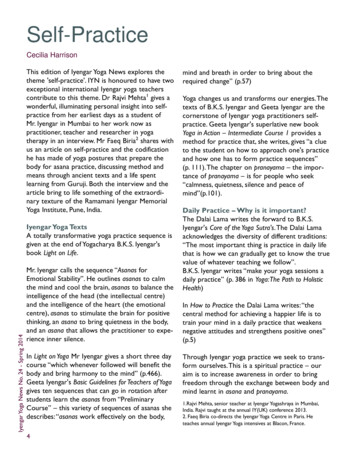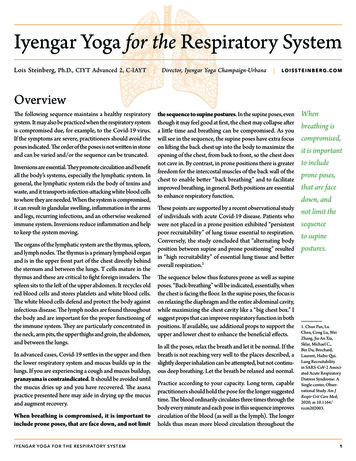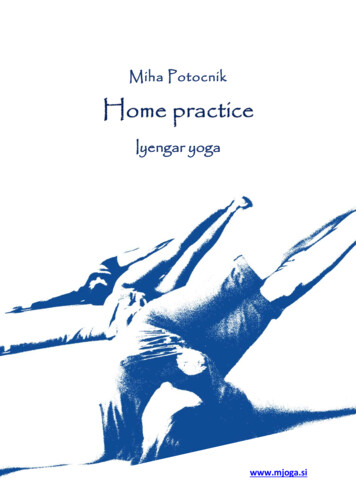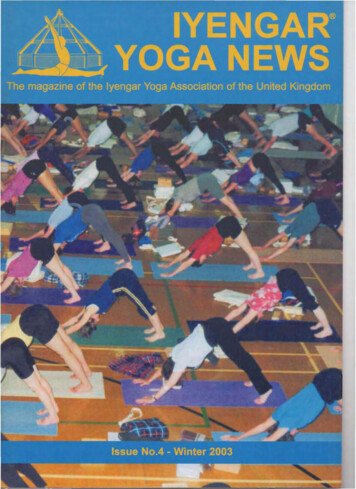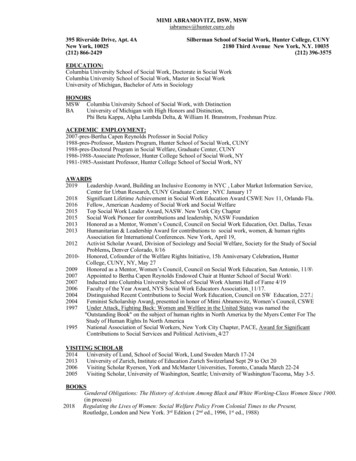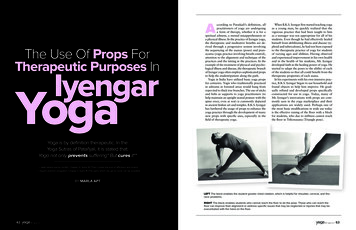
Transcription
AThe Use Of Props ForTherapeutic Purposes InIyengarYogaccording to Patañjali’s definition, allpractitioners of yoga are undergoinga form of therapy, whether it is for aspiritual ailment, a mental misapprehension ora physical illness. In the practice of Iyengar yoga,the therapeutic and meditative benefits are derived through a progressive system involvingthe sequencing of the asanas (poses) and pranayama (yogic practice involving breath control),attention to the alignment and technique of thepractices and the timing in the practices. In theexample of the treatment of physical and psychological illness and disease, the therapeutic branchof Iyengar yoga often employs sophisticated propsto help the student/patient along the path.Yogis in India have utilized basic yoga propsfor centuries. Yogis who traditionally practicedin ashrams in forested areas would hang fromropes tied to thick tree branches. The use of sticksand belts as supports to yoga practitioners (tohelp maintain an upright seated posture with thespine erect, even at rest) is commonly depictedin ancient Indian art and temples. B.K.S. Iyengarhas furthered the usage of props to enhance theyoga practice through the development of manynew props with specific uses, especially in thefield of therapeutic yoga.When B.K.S. Iyengar first started teaching yogaas a young man, he quickly realized that thevigorous practice that had been taught to himas a teenager was not appropriate for all of hisstudents. Even though he had effectively healedhimself from debilitating illness and disease (typhoid and tuberculosis), he had not been exposedto the therapeutic practice of yoga for studentsof varying ages and abilities. Having observedand experienced improvement in his own healthand in the health of his students, Mr. Iyengardeveloped faith in the healing power of yoga. Hestarted to adapt the poses to the ability of eachof the students so that all could benefit from thetherapeutic properties of each asana.In his experiments with his own intensive practice, B.K.S. Iyengar began to use household andfound objects to help him improve. He gradually refined and developed props specificallyconstructed for use in yoga. Today, many ofMr. Iyengar’s innovations with props are commonly seen in the yoga marketplace and theirapplications are widely used. Perhaps one ofthe most basic modifications in wide use todayis the effective raising of the floor with a blockfor students, who due to stiffness cannot reachthe floor in Trikonasana (Triangle pose).Yoga is by definition therapeutic. In theYoga Sutras of Patañjali, it is stated that:Yoga not only prevents suffering* But cures it**— tatah klesha karma nivrittih; Chapter IV. Sutra 30 (Then comes the end of afflictions and action)— heyam dukham anagatam; Chapter II, Sutra 16 (The pains which are yet to come can be avoided)***BY MARLA APTLEFT The block enables the student greater chest rotation, which is helpful for shoulder, cervical, and thoracic problems.RIGHT The block enables students who cannot reach the floor to do the pose. Those who can reach thefloor can improve their alignment or address specific issues that may be neglected or injuries that may beexacerbated with the hand on the floor.6263
EDUCATE The Use Of Props For Therapeutic Purposes In Iyengar YogaFunctions of Props:Support Education Direction Intensification of Action Relaxation and Stress ReductionSupportProps can serve several functions in a therapeutic context. In their supportive role propscan support the entire body in an asana orsupport the various parts of the body thatrequire rest. Often, the poses that are considered to be most beneficial for a particularcondition may not be attainable to the patient due to physical restrictions or lack ofstrength. The props can render some of themost advanced poses accessible to beginning,injured or disabled practitioners. For example, a student with only one leg can addressstructural imbalances in the pelvis sacrum andspine through the practice of standing poseswith the support of a tall bench and a trestle(wooden prop also referred to as “horse”). Orstudents unable to support themselves in aninverted pose such as Headstand (Sirsasana)can experience the many benefits of beingupside down while hanging in headstand onthe ropes. Some of the most advanced posescan provide the strongest medicine for various conditions and if not for the use of theprops, the medicine would not be within thepatient’s reach.In a therapeutic prescription the sequenceof the poses, the manner in which the poseis executed (the form and alignment) andthe amount of time each pose is held is asimportant as the poses prescribed. In theirsupportive capacity, props can enable thestudent to hold the pose for a much longerduration than when performed independently. Whereas a patient with yoga experiencemay be able to hold Viparita Dandasana (aninverted backbend) for one minute, he orshe can more easily hold the pose for 5-1064LEFT Ustrasana (Camel Pose) RIGHT Ustrasana with chair and bolster and blanketsAs a support, a prop can also help the patientovercome fear (of falling, losing balance, etc.).Fear can prove to be an impediment in theyoga practice. The protection response to fearcan frequently cause one to hold the breath,to tighten the very muscles and organs thatneed to relax and extend, or to compensatewith gross misalignments in the pose that candestabilize the pose and make one vulnerableto injury.LEFT Sirsasana (Headstand) on ropesRIGHT Sirsasana between two chairsminutes with the support of a chair and notonly experience some relaxation in this intense pose but also reap the benefits from aprolonged stay in the pose.Virabhadrasana III with support of trestle & stools65
EDUCATE The Use Of Props For Therapeutic Purposes in Iyengar YogaPranayama can be quite effective in treatingcertain respiratory, nervous, blood pressure,cardiac and psychological disorders. Pranayama is classically practiced in an upright seatedposition, that when done properly, requires agreat deal of strength, endurance and elasticityestablished from a foundation of asana practice.If the posture and technique of pranayama arenot executed correctly, the practice can causeundue strain to the structural body as well asthe nervous system and mind. In order to cultivate the body and the mind for pranayama,it can be practiced in a supine position in asupported version of Savasana (Corpse pose)rather than in a seated position. The brain andnerves relax while one is lying down. The propsupport improves respiratory functioning andallows the organs involved in the respiratoryprocess to broaden and take the shape requiredfor stress-free pranayama practice.Parivrtta Trikonasana at trestle/horseDirectionSupported Savasana with blankets, eye bandage and weightEducationProps can help cultivate an understandingof the correct alignment in the pose so thatthe pose is done safely. Many structural andsystemic problems are caused or exacerbatedby an imbalance in the body forming habitsthat persist, if unchecked, when performingasanas. The props can help form a kind offrame for the body, so that the student canfeel where the asymmetries occur- by observing the discrepancy of the contact between66the body and the prop from side to side. Inits educational function, the prop serves as ateacher to help the patient study one’s ownalignment and state of being, and often revealsthe source of the problem, empowering thepatient in the healing process. The prop canteach one to see and feel oneself from within. The introspection facilitated by the propincreases the meditative effects and mentalbenefits of yoga.Props can also be used in a directive manner soas to highlight a specific aspect of the posture orbreath. In this function, the prop calls attentionto the area that needs to be addressed for theailment and provides the student with a senseof direction. The prop directs the student to theparticular action of a pose that is therapeutic.For example, a student with cervical spondylosismay be very stiff and immobile in the cervicaland thoracic region and cannot independentlyproduce the necessary actions in the asanas thatwill create traction for the neck. However, withthe help of a rope harnessed around the trapeziusmuscles and pulled downward, the prop can offerrelief from pain and, at the same time, teach thestudent the action he or she is seeking to replicate.Intensification of ActionsProps can be used to intensify the actions requiredin a therapeutic application of a pose. Whilethe props can support and enable the studentto hold the pose for a longer period of time, thepose can be made more intense or can take thestudent deeper into the position through thespecific placement of the prop. In some therapeutic sequences, for example, the intensivecontraction of the kidneys, extension of the neck,or elongation of the liver are required to treat a67
EDUCATE The Use Of Props For Therapeutic Purposes in Iyengar Yogaparticular ailment. A heart patient may be givena pose designed to rest the student, lower bloodpressure and reduce stress, while at the sametime strongly opening the chest cavity, specifically the area proximate to the heart. The propsenable the surrounding body to relax while thetargeted areas work more intensively. The propcan transform a pose that could be potentiallyharmful when done incorrectly, to a pose thatbrings tremendous relief.Relaxation andStress ReductionProps have proven to be invaluable in the treatment of immune disorders. For relaxation andstress reduction, B.K.S. Iyengar developed whatis commonly referred to as a restorative practice,in which props support the student innovativeways so that the poses can be held for optimalamounts of time. Inversions are a critical toolto aid the immune system and props enable students to hold inversions for prolonged periodsfor maximal benefit.Paryankasana with brickProps can be used in different ways to enhancespecific aspects of a particular pose. A single posecan be altered through numerous prop setups totreat a full range of therapeutic issues rangingfrom structural to organic to psychological.TOP LEFT Setubandha Sarvangasana over cross bolsters creates space in pelvis and relaxes pelvic organs (menstruation) BOTTOM LEFT Setubandha Sarvangasana on bench nourishes heart, lungs (asthma,colds), helps with immune disorder, fatigue RIGHT Setubandha Sarvangasana (Bridge Pose) with ropesgives lumbar extension and open chest cavity68Different variations with props of Sarvangasana (shoulderstand) cycle. CLOCKWISE FROM LEFTNiralamba Sarvangasana at wall benefits systemic problems (endocrine, etc.) relieves mental fatigue,benefits reproductive organs; Sarvangasana on Chair increases chest opening (cardiac patients,shoulder problems), reduces pressure on head and lungs (high blood pressure, asthma, neck problems, mental fatigue), abdominal organs relax (gastrointestinal problems, pregnancy); Sarvangasaat trestle improves spinal alignment (disc, sciatica, back ache), increases circulation around spine(arthritis, degeneration, of disc/bone), relieves neck pain; Ardha Halasana with bench rests body andmind, decreases insomnia, relaxes back muscles; Supta Konasana with legs on bolsters on chairsopens pelvic region and widens buttock bones (constipation, hemorrhoids, pregnancy) and increasescirculation to pelvic region.69
EDUCATE The Use Of Props For Therapeutic Purposes in Iyengar YogaLike the use of medical instruments, the useof props is an exacting science. The patient’sage, mobility, responsiveness to instruction andpain, psychological state and strength must allbe taken into consideration and adapted to eachindividual. Before a pose can be modified withthe use of a prop, its properties and qualitiesmust be understood thoroughly. As with anyhealing modality, rigorous training is required.Yoga therapy not only relies on observation skillsand correct application but also on practical andpersonal experience. B.K.S. Iyengar conducts daily medical classes at his Institute in Pune, India,where innovations in the treatment of diseasesand ailments (ranging from Parkinson’s, cardiac,polio, scoliosis, spinal & disc injuries, depression,etc.) with the use of props are developed. YogaTherapy can therefore not be seen as a separate career path from Yoga practitioner/teacher.Without practicing the art under the guidanceof a senior practitioner, Yoga Therapy cannotbe effective and can even be harmful.Types of PropsMaterialWorks OnWood,MetalBonesCottonRopeSand, ironEyeBandageVarioussmall PiecesFlesh, skinLigaments/JointsNerves/InflammationSensory deprivation/stress disordersSpecific support,StabilityExamplesblocks, chairs, benches, quarter rounds,slanting planks, wedges, stumps, horse/trestle, poles, stoolsblankets, bolsterbelt, wall ropesweights, sandbagswooden pieces, foam wedges, squaresand rectangles, mat pieces, small clothsMarla Apt, a Senior level Iyengar Yoga teacher based in Los Angeles, was highlighted by Yoga Journal magazine asone of twenty-one young yoga teachers helping to shape the future of yoga. She has studied in India with BKS Iyengarand his family in India for many years, including a year of study in Pune, India. Marla leads workshops and teachertrainings around the world and has been involved with medical research studies on the therapeutic effects of yoga forvarious conditions. She is pursuing her interest in making the healing benefits of yoga available to communities in needas founding board member of the non-profit organization, Iyengar Yoga Therapeutics. Learn more at yoganga.com.* - photographs from: BKS Iyengar, Light on Yoga 70Article originally posted on yogana.com
of Iyengar yoga often employs sophisticated props to help the student/patient along the path. Yogis in India have utilized basic yoga props for centuries. Yogis who traditionally practiced in ashrams in forested areas would hang from ropes tied to thick tree branches. The use of sticks and belts as supports to yoga practitioners (to help maintain an upright seated posture with the spine erect .
